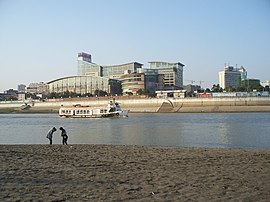

| Han River
Han Jiang / Hanshui
| |
|---|---|

The Han River in Wuhan
| |

Map highlighting watershed of the Han Jiang
| |
| Native name | 汉江 |
| Location | |
| Country | China |
| Region | Shaanxi, Hubei |
| Cities | Hanzhong, Ankang, Shiyan, Xiangyang, Xiantao, Wuhan |
| Physical characteristics | |
| Source | Near Hanzhong |
| • location | Qin Mountains, Shaanxi |
| • coordinates | 33°08′32″N 106°49′42″E / 33.14222°N 106.82833°E / 33.14222; 106.82833 |
| • elevation | 580 m (1,900 ft) |
| Mouth | Yangtze River |
• location | Wuhan, Hubei |
• coordinates | 30°33′52″N 114°17′30″E / 30.56444°N 114.29167°E / 30.56444; 114.29167 |
• elevation | 75 m (246 ft) |
| Length | 1,532 km (952 mi), Northwest-southeast |
| Basin size | 174,300 km2 (67,300 sq mi) |
| Discharge | |
| • average | 1,632 m3/s (57,600 cu ft/s) |
| • maximum | 33,500 m3/s (1,180,000 cu ft/s) |
| Basin features | |
| River system | Yangtze River basin |
| Tributaries | |
| • left | Xun, Dan, Bai River (China) [zh], Fushui River |
| • right | Du, Chi, Nan, Muma |
| Han River | |||||||||
|---|---|---|---|---|---|---|---|---|---|
| Traditional Chinese | 漢江 | ||||||||
| Simplified Chinese | 汉江 | ||||||||
| Literal meaning | Han River | ||||||||
| |||||||||
| Traditional Chinese | 漢水 | ||||||||
| Simplified Chinese | 汉水 | ||||||||
| Literal meaning | Han River (not "Han water") | ||||||||
| |||||||||
The Han River, also known by its Chinese names Hanshui (Chinese: 汉水) and Han Jiang (汉江), is a major river in Central China. A left tributary of the Yangtze, the longest river in Asia, it has a length of 1,532 km (952 mi) and is the longest tributary of the Yangtze system.
The river gave its name to the ancient Chinese Han dynasty, which marked one of ancient China's first golden ages and through it, to the Han Chinese, the dominant ethnic group in modern China and the most populous ethnic group in the world.[1] It is also the namesake of the city of Hanzhong on its upper course.
The headwaters of the Han flow from Mount Bozhong in southwestern Shaanxi.[2] The stream then travels east across the southern part of that province.[2] Its highland valley—known as the Qinba Laolin[a]—divides and is protected by the Qinling or Qin Mountains to its north and the Dabashan or Daba Mountains to its south.[2] The main cities are Hanzhong in the west and Ankang in the east. It then enters Hubei. It crosses most of Hubei from the northwest to the southeast, flowing into the Yangtze at the provincial capital Wuhan,[2] a city of several million inhabitants. The merging rivers divide the city of Wuhan into three sections: Wuchang in the south, Hankou to the northeast of the confluence, and Hanyang to its southwest. The area surrounding the confluence is known as the Jianghan Plain.[2]
Apart from a few major basins, such as the area around Hanzhong, the highlands of the Han were covered in primeval forests as late as the 19th century. The Nanshan Forest covered the northern slopes; the Bashan Forest, the southern.[3]

Danjiangkou Dam was constructed on the Han River in northern Hubei in 1958. It has been heightened since. The Danjiangkou Reservoir created thereby is now used as part of the South–North Water Transfer Project.
The river was previously considered holy by the inhabitants on its banks.[2] It is also considered part of the dividing line between northern and southern China.[2]
The name 'Han' was derived from the Han River, an upper tributary of the Yangtze River. It was further strengthened by the famous Han Empire (206 BC–220 AD) which lasted for several hundred years when the people began active interactions with the outside world.
|
| |
|---|---|
| Yangtze system |
|
| Yellow system |
|
| Pearl system |
|
| Heilongjiang system |
|
| Huai system |
|
| Hai system |
|
| Liao system |
|
| Other major rivers |
|
| Major canals |
|
| International |
|
|---|---|
| National |
|
This article related to a river in China is a stub. You can help Wikipedia by expanding it. |